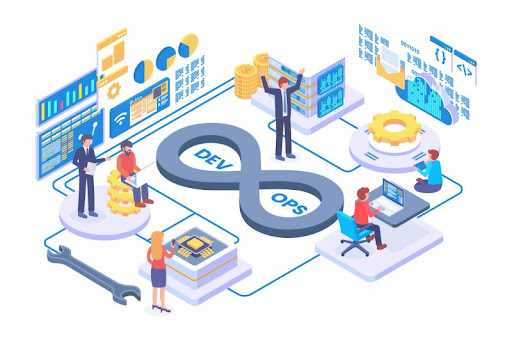
The meaning and operation of DevOps. How to implement it?
DevOps is a set of practices and tools that unify and automate the tasks of software development and operations across the entire service lifecycle. The value creation and delivery to users becomes faster, and the user can receive the emerging needs, bugs and defects sooner after development and repair. This improves the quality of the software produced and thus its competitiveness. For most companies, the introduction of DevOps can therefore be very beneficial, but often it can still cause problems.
In this article, we will review what DevOps is, what the process looks like and what the benefits are. We'll talk about the difficulties of getting started and give some advice on how to get started.

The meaning of DevOps
The term DevOps is a combination of the words Development and Operations. It refers to a set of practices and tools that unify and automate the tasks of software development and operations across the entire service lifecycle.
How DevOps works
DevOps is all about software developers and IT operators working together throughout the service lifecycle, with the aim of getting the product to market faster and the quality of the finished product higher. As this is a completely different approach from traditional software development models, it requires organisational and cultural changes:
- Close cooperation between development and operational staff is a key element
- Continuous communication between actors in the product production and supply chain is essential
- Technological automation is becoming more and more important.
In the DevOps model, development teams and operators can no longer work in separate departments. In many cases, the two teams are effectively merged, with engineers working together from design, through development and testing, to full operations. The team becomes cross-functional and takes responsibility for the whole life cycle of the product.

The DevOps lifecycle
The DevOps lifecycle consists of 8 phases, which at the end of the lifecycle interlock and restart. This is why DevOps is usually depicted by practitioners as an endless loop. The left side of the loop consists of the development phases and the right side of the loop consists of the operational phases
Phase 8 is as follows:
- Plan
- Code
- Build
- Test
- Release
- Deploy
- Operate
- Monitor
DevOps exercises
The soul of DevOps is the learning and continuous application of DevOps practices. Let's see what makes DevOps different!
Continuous Integration (CI)
Continuous integration means that changes to the code or new code are automatically uploaded to the software on a daily or multiple daily basis.
This way, new builds are immediately available and tested very quickly. This helps DevOps teams address bugs faster, improve software quality and reduce the time needed to validate and release new software updates.
Continuous delivery
Continuous delivery is effectively an extension of continuous integration, as code changes are made frequently and automatically. As a result, users can provide continuous feedback on the latest version and developers can quickly modify or improve the software as needed. The resulting software can meet the real-time needs of users, which greatly increases competitiveness.
Automation
Automation is central to DevOps, as it can significantly increase the speed of developing and deploying high-quality software.
IaC - Infrastructure managed as code
IaC goes beyond simply scripting the infrastructure configuration by treating the infrastructure definitions as real code, applying code validation, tests, and allowing the definitions to be stored and restored as needed. This has the advantage of allowing rollback in the event of version change issues, which provides enormous security.
Microservice
Microservice is an architectural technique where instead of a monolithic application, the application is built as a collection of smaller services. These microservices can be operated and deployed independently of each other and communicate with each other through an interface.
The biggest advantage of this practice is flexibility, as microservices can be modified and developed more often and faster, and their small size increases their reliability.
Monitoring
DevOps teams monitor the entire development lifecycle, allowing them to react quickly and automatically
DevSecOps
With continuous integration and delivery and a high degree of automation, it is very important to build security into the mix. This can be achieved through active security audits and testing in Agile and DevOps processes.

DevOps tools
DevOps teams use a variety of tools to automate and accelerate processes and to deliver on the core concepts of DevOps - continuous delivery, continuous delivery, automation and collaboration.
The different Devops tools help you solve the challenges of each stage. They can improve collaboration, prevent misunderstandings, help automate or facilitate monitoring and surveillance.
Here are a few tools to get to know if you are working in the DevOps model:
- Versioning, coding: Jira, Git (GitLab, GitHub, Bitbucket)
- Build tool: Maven
- Release Tool: Jenkins, Travis, Bamboo
- Configuration management: Puppet, Ansible, Saltstack Chef
- Container Platform: Docker, Kubernetes
- Communication and cooperation: Slack
- Cloud storage: AWS, Azure, Google Cloud Platform
- Monitoring, alarm and incident reporting system: Appdynamics, Raygun, Spunk Cloud
- Testing: Selenium, Gremling
- IT Ticketing: Servicenow
- Status Service Updates: The Status Page
The benefits of DevOps
- Thanks to continuous delivery, the product develops much faster, both at the development, testing and application level
- Thanks to greater collaboration, the software produced is much more tailored to the environment in which it will be used
- Thanks to continuous bug fixes and new features, the software is constantly updated, increasing user satisfaction and competitiveness
- Practices such as continuous integration and delivery guarantee that changes are operational and safe. And monitoring provides real-time information on performance
What are the challenges of implementing DevOps?
When implementing DevOps, the biggest challenge is to reshape old ingrained habits in the minds of teams. This is often met with resistance, or often just doesn't add up in the minds of the staff. What do we need to look out for?
- It is very important that development and operations cease to be separate departments
- It must be understood that DevOps is not just about introducing new tools, but about a new culture and vision
- Those involved in the process need to understand the whole value chain, from ideation to end-user experience
A further problem could be the shift to micro-services, which promises faster production and innovation but also comes with an increased burden. It is therefore crucial to first build a solid foundation of automation, configuration management and continuous delivery practices. Team building comes next, and the last step is to build the asset chain.
Advice for implementing DevOps
Think small first!
The easiest way to implement DevOps is to select a small value chain, such as a supporting application or service, first. This value chain is where you should start learning and testing the DevOps practices part.
Creating autonomous teams
Further implementation of DevOps requires a high level of commitment from the organisation to review, change and possibly eliminate certain teams, processes or tools. The goal is to create a system that gives teams the autonomy they need to develop and operate without having to rely too heavily on other, external teams.
Continuous learning
For DevOps to work properly, experimentation and a certain degree of risk-taking must be encouraged. You need to create an environment where team members dare to come up with unique solutions and where failure is accepted.
Combining with agile methodologies
Agile methodologies are particularly popular in software development. The main reason for their popularity is that agile teams are inherently flexible, well-organised and able to respond well to change. All this fits perfectly with the cultural change required for DevOps, which is why using agile and DevOps tools together greatly increases efficiency and reliability.
If you have questions about how DevOps works, how to implement it or need help, our consultants with a background in development can provide practical solutions and support.
Contact us for more information!

 Designabc
Designabc